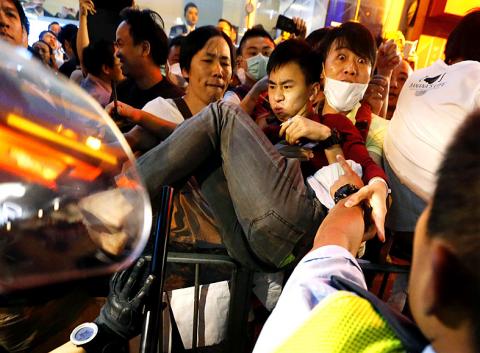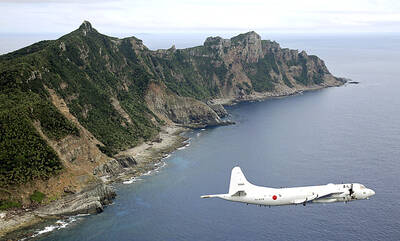Hong Kong riot police used pepper spray and baton-charged crowds of pro-democracy protesters last night as tension escalated after a pre-dawn clearance of a major protest zone in the Chinese-controlled financial hub.
Crowds of protesters headed to the gritty and congested Mong Kok district after work and school last night, across the harbor from the heart of the civil disobedience movement near government headquarters, to try to reclaim sections of an intersection that police had cleared in a surprise raid early yesterday morning.
Hundreds of protesters tried to break through police lines and they used open umbrellas to shield themselves from pepper spray. In the melee, police used batons and scuffled violently with activists.

Photo: Reuters
Police hauled off several protesters as others shouted insults and chanted “open the road.”
The protesters, led by a restive generation of students, have been demanding that the China’s rulers live up to constitutional promises to grant full democracy to the former British colony, which returned to Chinese rule in 1997.
Before dawn yesterday, hundreds of police officers staged their biggest raid yet on a pro-democracy protest camp, charging down student-led activists who had held the intersection in one of their main protest zones for more than three weeks.
The operation came while many protesters were asleep in dozens of tents or beneath giant, blue-striped tarpaulin sheets.
The raid was a gamble for the 28,000-strong police force, who have come under criticism for aggressive clearance operations with tear gas and baton charges and for the beating of a handcuffed protester on Wednesday.
Storming into the intersection with helmets, riot shields and batons at the ready from four directions, the 800 officers caught the protesters by surprise. Many retreated without resisting.
“The Hong Kong government’s despicable clearance here will cause another wave of citizen protests,” radio talk-show host and activist Wong Yeung-tat (黃洋達) said earlier.

MISINFORMATION: The generated content tends to adopt China’s official stance, such as ‘Taiwan is currently governed by the Chinese central government,’ the NSB said Five China-developed artificial intelligence (AI) language models exhibit cybersecurity risks and content biases, an inspection conducted by the National Security Bureau (NSB) showed. The five AI tools are: DeepSeek, Doubao (豆包), Yiyan (文心一言), Tongyi (通義千問) and Yuanbao (騰訊元寶), the bureau said, advising people to remain vigilant to protect personal data privacy and corporate business secrets. The NSB said it, in accordance with the National Intelligence Services Act (國家情報工作法), has reviewed international cybersecurity reports and intelligence, and coordinated with the Ministry of Justice Investigation Bureau and the National Police Agency’s Criminal Investigation Bureau to conduct an inspection of China-made AI language

LIMITS: While China increases military pressure on Taiwan and expands its use of cognitive warfare, it is unwilling to target tech supply chains, the report said US and Taiwan military officials have warned that the Chinese People’s Liberation Army (PLA) could implement a blockade within “a matter of hours” and need only “minimal conversion time” prior to an attack on Taiwan, a report released on Tuesday by the US Senate’s China Economic and Security Review Commission said. “While there is no indication that China is planning an imminent attack, the United States and its allies and partners can no longer assume that a Taiwan contingency is a distant possibility for which they would have ample time to prepare,” it said. The commission made the comments in its annual

‘TROUBLEMAKER’: Most countries believe that it is China — rather than Taiwan — that is undermining regional peace and stability with its coercive tactics, the president said China should restrain itself and refrain from being a troublemaker that sabotages peace and stability in the Indo-Pacific region, President William Lai (賴清德) said yesterday. Lai made the remarks after China Coast Guard vessels sailed into disputed waters off the Senkaku Islands — known as the Diaoyutai Islands (釣魚台) in Taiwan — following a remark Japanese Prime Minister Sanae Takaichi made regarding Taiwan. Takaichi during a parliamentary session on Nov. 7 said that a “Taiwan contingency” involving a Chinese naval blockade could qualify as a “survival-threatening situation” for Japan, and trigger Tokyo’s deployment of its military for defense. Asked about the escalating tensions

DISPUTE: A Chinese official prompted a formal protest from Tokyo by saying that ‘the dirty head that sticks itself out must be cut off,’ after Takaichi’s Taiwan remarks Four armed China Coast Guard vessels yesterday morning sailed through disputed waters controlled by Japan, amid a diplomatic spat following Japanese Prime Minister Sanae Takaichi’s comments on Taiwan. The four ships sailed around the Senkaku Islands — known as the Diaoyutai Islands (釣魚台) to Taiwan, and which Taiwan and China also claim — on Saturday before entering Japanese waters yesterday and left, the Japan Coast Guard said. The China Coast Guard said in a statement that it carried out a “rights enforcement patrol” through the waters and that it was a lawful operation. As of the end of last month,